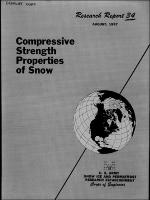Please use this identifier to cite or link to this item:
https://hdl.handle.net/11681/2748Full metadata record
| DC Field | Value | Language |
|---|---|---|
| dc.contributor.author | Jellinek, H. H. G. (Hans Helmut Gunter), 1917- | - |
| dc.date.accessioned | 2016-03-14T19:23:27Z | - |
| dc.date.available | 2016-03-14T19:23:27Z | - |
| dc.date.issued | 1957-08 | - |
| dc.identifier.uri | http://hdl.handle.net/11681/2748 | - |
| dc.description | Research Report | - |
| dc.description | Summary: The compressive strength of snow cylinders was investigated as a function of age of snow, snow-particle size, and age of the cylinders. The effect of gases such as carbon dioxide, methane, and ammonia on the strength of snow cylinders has also been studied. The experimental results show that the older the snow from which snow cylinders are made, the smaller the compressive strength. The compressive strength of cylinders decreases with the snow particle size. An equation describing the aging curves for snow cylinders is presented. Whereas carbon dioxide and methane in small quantities have no effect on the compressive strength, ammonia appreciably lowers the compressive strength of snow cylinders. All strength measurements were carried out at -10°C. | - |
| dc.publisher | U.S. Army Snow, Ice, and Permafrost Research Establishment. | - |
| dc.publisher | Engineer Research and Development Center (U.S.) | - |
| dc.relation | http://acwc.sdp.sirsi.net/client/en_US/search/asset/1020460 | - |
| dc.relation.ispartofseries | Research report (U.S. Army Snow | - |
| dc.rights | Approved for public release; distribution is unlimited. | - |
| dc.source | This Digital Resource was created from scans of the Print Resource | - |
| dc.subject | Snow | - |
| dc.subject | Snow strength | - |
| dc.subject | Compressive strength | - |
| dc.subject | Snow mechanics | - |
| dc.subject | Snow physics | - |
| dc.subject | Snow impurities | - |
| dc.title | Compressive strength properties of snow | - |
| dc.type | Report | en_US |
| Appears in Collections: | Research Report | |
Files in This Item:
| File | Description | Size | Format | |
|---|---|---|---|---|
| SIPRE-Research-Report-34.pdf | 11.57 MB | Adobe PDF |  View/Open |